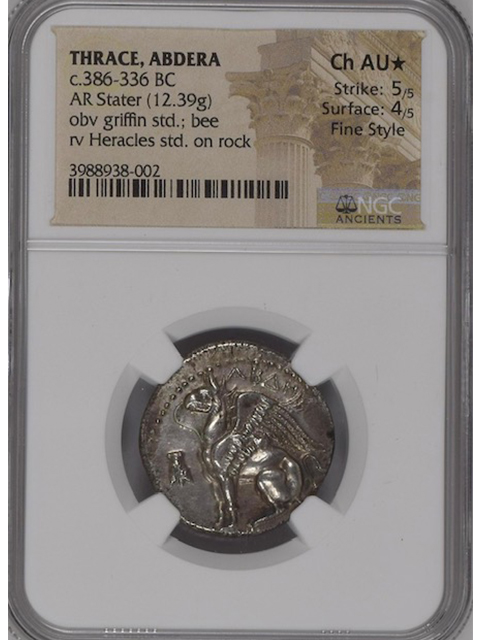重量: 12,39グラム
鋳造期間:NGC表記 紀元前386年〜336年! (紀元前395年〜360年と思いますが。。。)
鋳造地:古代ギリシャ都市「アブデラ」
表面: Griffin (ΑΒΔH)
裏面: ヘラクレス(ΕΠΙΦΙΛΑ– ΔΟΣ)
NGC鑑定番号: 3988398-002
NGC鑑定番結果: CH AU STAR / FINE STYLE !
特記: アブデーラ(現在のアヴディラ)(古代ギリシア語: Ἄβδηρα/ Ábdēra)は、トラキア地方にある古代ギリシアの都市。長音を省いて「アブデラ」とも表記される。ソフィストのプロタゴラスや、原子論を確立した哲学者デモクリトスの故郷としても知られる。
専門書:
Weber 2379. Jameson 2000、SNG Lockett 1132. May, Abdera 393
ギリシャ神話において、アブデラの町は、死んだアブデロスの友人であったヘラクレスが造ったとされる。
歴史的にはイオニア地方の都市クラゾメナイ(現在のウルラ付近)からの入植者が建設したという。
言い伝えでは、紀元前654年に建設されたと言われている。検証はされていないが、紀元前7世紀に作られたとみられるギリシアの陶器が発掘されていることから、ほぼ事実であると言える。アブデラの町は繁栄し、紀元前544年にはアケメネス朝ペルシアへの服従を嫌ったテオスの町の住民の大部分がアブデラに移住した。詩人のアナクレオンもこの一人であった。
アブデラ製の貨幣には、テオスと同じく「グリフィン」が描かれていて、特に銀貨の裏面の模様は多くの種類があり、美しかったという。
紀元前513年と紀元前512年にはアブデラはアケメネス朝に攻略された。紀元前492年には再び町をダレイオス1世に占領された。その後はデロス同盟に加盟し、アテナイ側でペロポネソス戦争を戦った。
アブデラはトウモロコシの生産や、内陸部にすむトラキア人やオドリス王国との交易における主要港となったことから、デロス同盟で3番目に豊かな町となった。そのためにアブデラの町は度々略奪された。紀元前376年にはトリバリ人、紀元前350年にはマケドニア王国のフィリッポス2世やリュシマコス、セレウコス朝、プトレマイオス朝などによってであった。紀元前170年には共和政ローマが、またペルガモン王国のエウメネス2世がアブデラの町を包囲し、略奪したこともあった。
紀元前4世紀半ばになるとアブデラの町はやや衰退した。アテナイでは、ことわざで「アブデラの雰囲気」は「愚かなことをすること」を意味したが、実際は哲学者のデモクリトスや歴史家・懐疑主義哲学者のヘカタエオスなどの有名な人物をアブデラは輩出している。
現在では、アブデラの遺跡はバラストラ岬から見ることができる。7つの小高い丘には東から西の港に至るまで遺跡が広がっており、南側には中世のポリスティロン (Polystylon) の町の遺跡が残っている。アブデラにはローマ・カトリックの名義司教座が置かれている。
Stater circa 395-360 BC,
AR 12.39 grams. The obverse features ΑΒΔH with a Griffin seated, facing left; in left field, cicada. On the Reverse is ΕΠΙΦΙΛΑ– ΔΟΣ with Heracles seated half right on lion's skin draped over a rock. He holds a club vertically in his right hand while resting his left elbow on his left thigh. Weber 2379. Jameson 2000 (this obverse die). SNG Lockett 1132. May, Abdera 393.
Extremely rare !!!
The only Highest Graded. The Most Exeptional
An issue of excellent style with a superb, light, old cabinet toning.
The city of Abdera in coastal central Thrace was founded in 544 B.C. by refugees from the Ionian island of Teos fleeing the Persian conquest of Asia Minor from the Ionian island of Teos. With a ready supply of silver and the experience of a well-established preexisting coinage in their homeland, the colonists began minting their own coinage about a decade after settlement at Abdera. Although rare today, the first issues were apparently quite large and consisted of octodrachms and tetradrachms, employing the obverse type of their homeland, a seated griffin with the single difference being that the griffin is invariably shown facing to the left at Abdera whereas it was always shown to the right on the coinage of Teos. The griffin remained the civic badge of the city, appearing on Abdera's coinage right down until her conquest by Philip II of Macedonia in the 350s B.C. The reverse type soon developed from a simple incuse punch to contain various designs, often in conjunction with the name of the magistrate responsible for the issue of coinage.
The second half of the fifth century B.C. saw a flourishing of individualism and realism in art hitherto unprecedented, with artists attaining a manner of representation that conveys a vitality of life as well as a sense of permanence, clarity, and harmony. At Athens, the statesman Pericles transformed the Acropolis into a lasting monument to the city's newfound political and economic power, crowning the entirety in white Parian marble. The Parthenon, the magnificent Doric temple honoring the city's patron goddess Athena, was richly embellished with some of the finest sculptures, and within stood the colossal gold-and-ivory statue of Athena made by the great sculptor Pheidias. Elsewhere, the artists Lysippos and Praxiteles were in their prime. In the west, schools of renowned die engravers were busy cutting dies for the cities of Sicily, particularly at Syracuse.
The dies used to strike the present coin extend the artistic competence seen elsewhere throughout greater Hellas to the northern Aegean. Here, the griffin departs from the earlier issues in that it sits upright, forelegs together and neck arched, with the nearer wing sloped along the back and the further providing a startling and effective background to the whole. The reverse portrays the hero Herakles in a human light, appearing utterly exhausted and at rest, as if just catching his breath. He turns to look over his shoulder, providing a sense that he is lost in thought, perhaps reflecting on his recent endeavors. The effect is indulgent, and serves to connect the viewer to the world of Olympus and the travails of the immortals. The magistrate responsible for this particularly handsome issue is one Philas. The legend appearing along the perimeter of the reverse, ΕΠΙ ΦΙΛΑΔΟΣ, uses the genitive case of his name to show that he was responsible for the issue, and also carries the proposition ΕΠΙ, "in the period of office of."
